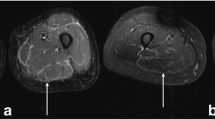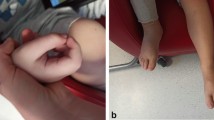Abstract
Eosinophilic fasciitis (EF) is a rare localized fibrosing disorder of the fascia whose diagnosis is often suspected based on clinical findings and laboratory values. These lab abnormalities can be transient in early disease and may not always be present. We have reviewed a case series of patients to assess the utility of the various laboratory abnormalities in diagnosing EF. We performed a retrospective review of EF patients seen at Georgetown University Hospital in the Division of Rheumatology during 2009 and 2013. This review included 15 adult patients with EF with a mean age at diagnosis of 45 years (range 18 to 77 years). The majority of patients 13/15 had classic skin thickening documented on all four extremities Only eight patients had peripheral eosinophilia ranging between 8 and 38 %. In these patients, the peripheral eosinophilia was an early but transient finding. Inflammatory markers including the erythrocyte sedimentation rate (ESR) was elevated in 5/14 and C-reactive Protein (CRP) was elevated in 7/11. At disease presentation, only one of eleven patients checked had an elevated creatine phosphokinase (CPK). Aldolase levels were available for 12 of the 15 patients, and they were increased in 11 out of 12 patients. We have found that in this case series, aldolase was more likely to be abnormal than peripheral eosinophilia, hypergammaglobulinemia, and ESR particularly after starting treatment. Aldolase should be measured in all patients suspected of having EF, and may also play a useful role in following disease activity.
Similar content being viewed by others
References
Shulman LE (1975) Diffuse fasciitis with eosinophilia: a new syndrome? Trans Assoc Am Physicians 88:70–86
Pinal-Fernandez I, Selva-O’Callaghan A, Grau JM (2014) Diagnosis and classification of eosinophilic fasciitis. Autoimmun Rev
Bischoff L, Derk CT (2008) Eosinophilic fasciitis: demographics, disease pattern and response to treatment: report of 12 cases and review of the literature. Int J Dermatol 47(1):29–35
Fujimoto M, Sato S, Ihn H, Kikuchi K, Yamada N, Takehara K (1995) Serum aldolase level is a useful indicator of disease activity in eosinophilic fasciitis. J Rheumatol 22(3):563–565
Taylor WC, Fulton BN, Persellin ST (2009) Eosinophilic fasciitis in a duathlete. Clin J Sport Med 19(2):147–149
Moulton SJ, Kransdorf MJ, Ginsburg WW, Abril A, Persellin S (2005) Eosinophilic fasciitis: spectrum of MRI findings. AJR Am J Roentgenol 184(3):975–978
Baumann F, Bruhlmann P, Andreisek G, Michel BA, Marincek B, Weishaupt D (2005) MRI for diagnosis and monitoring of patients with eosinophilic fasciitis. AJR Am J Roentgenol 184(1):169–174
Barnes L, Rodnan GP, Medsger TA, Short D (1979) Eosinophilic fasciitis. A pathologic study of twenty cases. Am J Pathol 96(2):493–518
Philen RM, Eidson M, Kilbourne EM, Sewell CM, Voorhees R (1991) Eosinophilia-myalgia syndrome. A clinical case series of 21 patients. New Mexico Eosinophilia-Myalgia Syndrome Study Group. Arch Intern Med 151(3):533–537
Nozaki K, Pestronk A (2009) High aldolase with normal creatine kinase in serum predicts a myopathy with perimysial pathology. J Neurol Neurosurg Psychiatry 80(8):904–908
Nakajima H, Fujiwara S, Shinoda K, Ohsawa N (1997) Magnetic resonance imaging and serum aldolase concentration in eosinophilic fasciitis. Intern Med 36(9):654–656
Mozaffar T, Pestronk A (2000) Myopathy with anti-Jo-1 antibodies: pathology in perimysium and neighbouring muscle fibres. J Neurol Neurosurg Psychiatry 68(4):472–478
Conflict of interest
Drs. Nashel and Steen have nothing to declare and have no disclosures and no conflict of interest related to this manuscript.
Author information
Authors and Affiliations
Corresponding author
Rights and permissions
About this article
Cite this article
Nashel, J., Steen, V. The use of an elevated aldolase in diagnosing and managing eosinophilic fasciitis. Clin Rheumatol 34, 1481–1484 (2015). https://doi.org/10.1007/s10067-014-2777-x
Received:
Revised:
Accepted:
Published:
Issue Date:
DOI: https://doi.org/10.1007/s10067-014-2777-x




